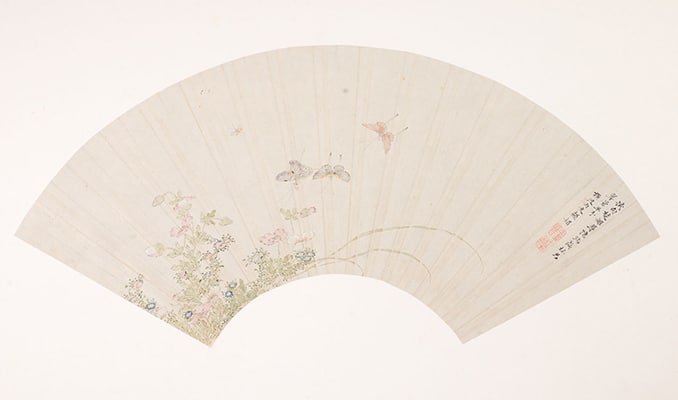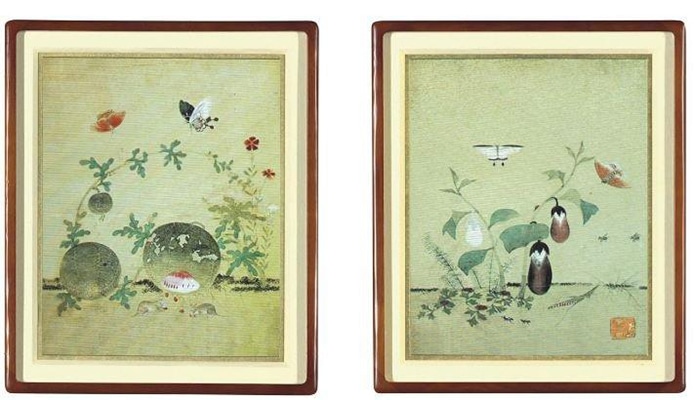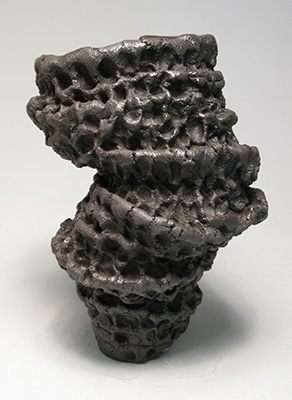If you’ve enjoyed watching butterflies flitting around you as you strolled amongst the tropical plants and flowers at the Florida Museum of Natural History, you won’t want to miss another opportunity to spend some time appreciating the butterflies at the neighboring Harn Museum of Art. In the current and forthcoming exhibitions in the Asian Wing, butterflies are represented in works of different media.
Butterflies have long been appreciated in Chinese culture as symbols of love, freedom, romance, and beauty. The image of butterflies lingering over flowers often suggests the felicitous union between a male and a female as women are often likened to blossoms. As a result, flowers and butterflies have become not only appropriate but also appealing motifs to Chinese female painters throughout history.

This fan painting, which will be displayed in the forthcoming exhibition, She/Her/Hers: Women in the Arts of China, from March 2022 onward, was painted by the 17th-century female painter Gu Mei (1619–1664, 顾媚). It depicts a few butterflies hovering above the gracefully rendered poppy and daisy blossoms. Seemingly a depiction of a pleasant summer garden suggesting the romantic attraction between men and women, this painting, however, reveals an air of melancholy in the painter’s poem written on the right side of the fan. Gu lamented in the poem that she tried to find the hidden place of Lady Fan, the consort of King Zhuang of Chu (r. 613–590 BCE), but only found the lush green woods. Lady Fan was best known as a worthy and enlightened female model because she often expressed earnest opposition to the king. Gu Mei’s unfulfilled longing is indeed referential to her own dilemma. One of the most sought-after courtesans in the 17th century, Gu became the concubine of the poet and scholar-official Gong Dingzi (1616–1673) right before the turbulent dynastic transition from the Ming (1368–1644) to the Qing (1644–1911) dynasties. Unable to persuade Gong to maintain his loyalty to the fallen dynasty, Gu aired her grievances in her painting through the deft use of poetic allusion. One is likely to be immediately attracted by the delicate and meticulous brushwork of this painting, yet a deeper understanding of the literary allusion reveals the mind and personality of the painter.

The most popular story about butterflies in China is the folktale “The Butterfly Lovers,” the so-called Chinese Romeo and Juliet. First appearing in the 4th century, the story relates a tragic romance between Liang Shanbo and Zhu Yingtai, the young couple who chose death rather than being forced apart by Zhu’s family. At the end of the tale, after Zhu committed suicide at Liang’s tomb, they turned into a pair of butterflies and flew towards their eternal happiness. The two butterflies not only represent their transformed bodies but also symbolize their desire for love and their hope for a reunion. As the tale spread across regions and times, the two butterflies gradually became symbols of conjugal fidelity in Chinese visual art. On a porcelain plate currently displayed in the Asian Wing’s Axline Gallery, a lady is seen sitting alone on a garden rock. She slightly tilts her head and seems fixated on two fluttering butterflies to her left. Hinting at coupling, the pair of butterflies represents the happiness of which she was deprived by the absence of her husband or lover. Her pensive look further testifies to the sentiment of her loneliness.

The butterfly is also a common subject in the Korean painting genre chochungdo 초충도, or paintings of insects and flowers. In the Harn’s Korean Art gallery, a recent change-out features contemporary Korean artist Lee Lee Nam’s (李二男, b. 1969) creative animation of two paintings of vegetables and butterflies by the 16th-century female Korean painter Shin Samdang (1504–1551). In Lee Lee Nam’s video works, the vitality suggested by the clapping wings of these butterflies transports viewers across time and space to a traditional Korean garden.
Butterflies continuously inspire artistic creation in contemporary Asia. In a painting of a butterfly by contemporary Chinese painter Zhang Yirong (张艺蓉, b. 1979), the artist complicates viewers’ understanding of this recurring motif by monumentalizing the meticulous details of the insect. Mark your calendar for the opening of our new exhibition, She/Her/Hers: Women in the Arts of China on March 1, 2022, to see the Harn’s new acquisition of Yirong’s Butterfly, which reimagines size and scale in challenging and spectacular ways.




